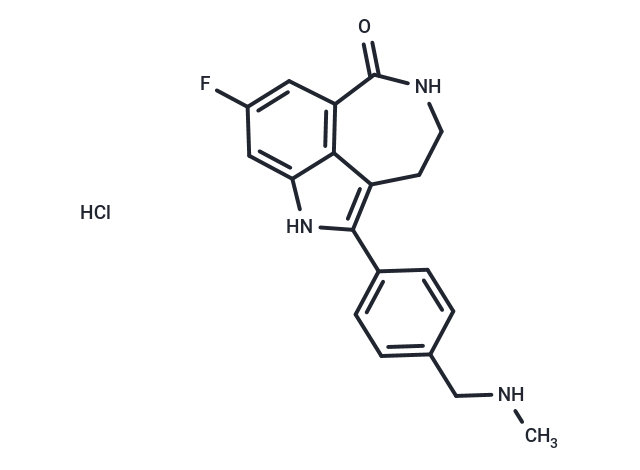Shopping Cart
Remove All Your shopping cart is currently empty
Your shopping cart is currently empty
Rucaparib hydrochloride, also known as AG014699, is a powerful and orally active compound that inhibits PARP proteins including PARP-1, PARP-2, and PARP-3 with a Ki value of 1.4 nM for PARP1. Additionally, Rucaparib hydrochloride acts as a modest inhibitor of hexose-6-phosphate dehydrogenase (H6PD). This compound shows potential in research for castration-resistant prostate cancer (CRPC) [1] [2] [3] [4].

| Pack Size | Price | USA Warehouse | Global Warehouse | Quantity |
|---|---|---|---|---|
| 25 mg | $2,140 | 1-2 weeks | 1-2 weeks | |
| 50 mg | $2,785 | 1-2 weeks | 1-2 weeks | |
| 100 mg | $3,520 | 1-2 weeks | 1-2 weeks |
| Description | Rucaparib hydrochloride, also known as AG014699, is a powerful and orally active compound that inhibits PARP proteins including PARP-1, PARP-2, and PARP-3 with a Ki value of 1.4 nM for PARP1. Additionally, Rucaparib hydrochloride acts as a modest inhibitor of hexose-6-phosphate dehydrogenase (H6PD). This compound shows potential in research for castration-resistant prostate cancer (CRPC) [1] [2] [3] [4]. |
| Targets&IC50 | PARP1:1.4 nM (Ki) |
| In vitro | Rucaparib (AG014699) hydrochloride, a potential N-demethylation metabolite of AG14644, exhibits cytotoxicity with an LC50 of 5 μM in Capan-1 (BRCA2 mutant) cells and 100 nM in MX-1 (BRCA1 mutant) cells after 24-hour exposure at concentrations ranging from 0.1 to 100 μM. Its mechanism of enhancing radio-sensitivity involves the inhibition of NF-κB activation downstream, independent of single-strand break (SSB) repair inhibition, allowing it to target NF-κB activated by DNA damage and counteract the toxicity linked with classical NF-κB inhibitors, without affecting essential inflammatory functions. Additionally, Rucaparib inhibits PARP-1 activity by 97.1% at a 1 μM concentration in permeabilised D283Med cells, showcasing its potent inhibitory effect on this enzyme. |
| In vivo | Rucaparib (AG014699) hydrochloride, in combination with Temozolomide, significantly enhances Temozolomide toxicity, increases Temozolomide-induced body weight loss, and results in a significant increase in tumor growth delay. At a dosage of 1 mg/kg, it markedly inhibits tumor growth, achieving a 50% increase in Temozolomide-induced tumor growth delay in specific models. Furthermore, when administered at varying doses (10 mg/kg intraperitoneally (i.p.) or 50, 150 mg/kg orally (p.o.); daily for five days per week for six weeks), Rucaparib hydrochloride significantly restricts the growth of tumors, producing one complete and two partial regressions. Remarkably, a regimen of 150 mg/kg, p.o., once or three times a week for six weeks, shows the most significant antitumor effect with three complete regressions noted. In addition, a daily 1 mg/kg i.p. dosage of Rucaparib hydrochloride, when combined with Temozolomide, substantially enhances antitumor activity, indicating complete and sustained tumor regression in specific xenografts. In varying animal models, including female athymic nude mice with SW620 colorectal tumor cells and CD-1 nude mice with established Capan-1 xenografts, Rucaparib administrations have demonstrated a consistent ability to sensitize tumors to Temozolomide, significantly inhibit tumor growth, and are detectable in plasma post-administration, highlighting its chemosensitization potency and effectiveness in enhancing Temozolomide-induced tumor growth delay. |
| Molecular Weight | 359.83 |
| Formula | C19H19ClFN3O |
| Cas No. | 773059-19-1 |
| Smiles | Cl.CNCc1ccc(cc1)-c1[nH]c2cc(F)cc3C(=O)NCCc1c23 |
| Storage | Powder: -20°C for 3 years | In solvent: -80°C for 1 year | Shipping with blue ice/Shipping at ambient temperature. |
| Size | Quantity | Unit Price | Amount | Operation |
|---|

Copyright © 2015-2026 TargetMol Chemicals Inc. All Rights Reserved.